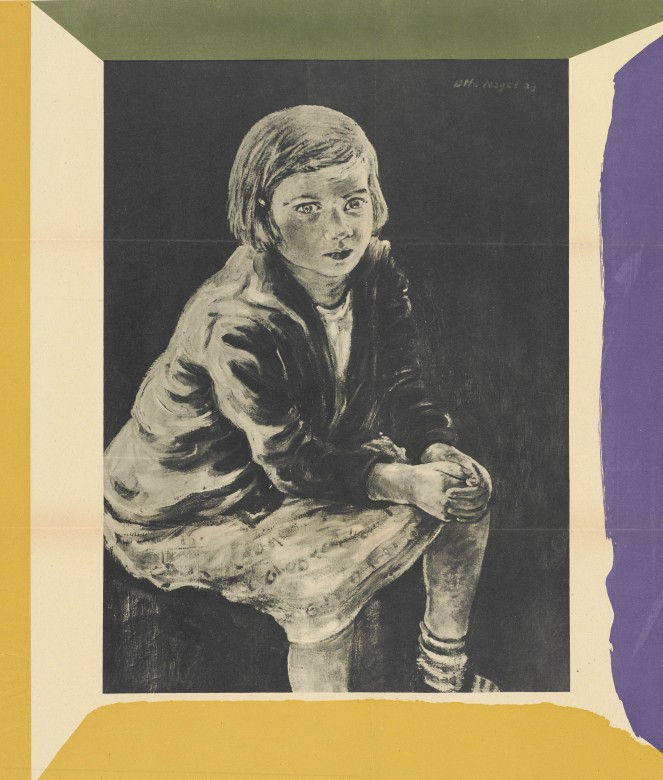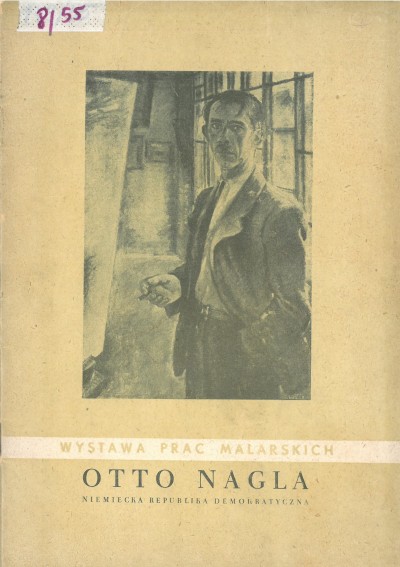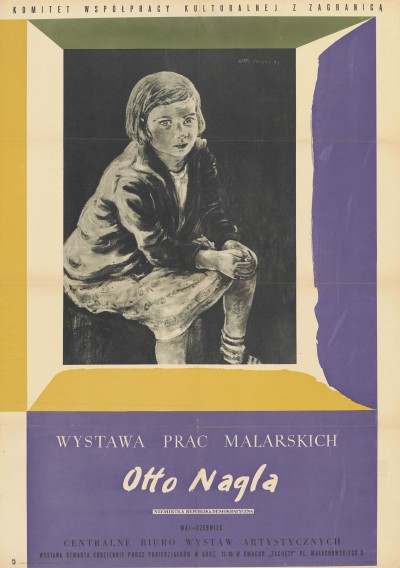Exhibition of paintings by Otto Nagel (East Germany)
24.05 – 12.06.1955 Exhibition of paintings by Otto Nagel (East Germany)
Zachęta Central Bureau of Art Exhibitions (CBWA)
commissioner (artistic supervisor): Otto Nagel
In the 1950s, as part of the collaboration with the Committee for Cultural Cooperation with Foreign Countries (KWKZ), the Central Bureau of Art Exhibitions (CBWA) hosted two exhibitions of works by German artists: Käthe Kollwitz (1951) and Otto Nagel (1955).[1] On the occasion of the Kollwitz exhibition and his visit to Warsaw in 1951, Otto Nagel made contacts and began a collaboration that led to his individual exhibition at Zachęta, as well as in Lublin at the Lublin Museum (24 June–24 July 1955), and a several days’ study visit in Poland.
The exhibition of works by Nagel in 1955 was, the second, after Käthe Kollwitz, individual exhibition prepared as part of the Polish-German cooperation inscribed in the programme of the KWKZ. As the press reported: ‘Present at the opening were, among others, Włodzimierz Sokorski, Minister of Culture and Art, and Jan Karol Wende, Secretary General of the Committee for Cultural Cooperation with Foreign Countries. The importance of the event was underlined by the East Germany state award for Otto Nagel and his numerous titles: Vice-President of the German Academy of Fine Arts and President of the German Artists’ Association.’[2]
90 works were presented at the exhibition: 19 oil paintings and 71 pastels. Most of them were pre-war works or those created during the war. Only 9 or 11 works (3 undated) came from the post-war period. The exhibition was accompanied by a catalogue with a list of works, selected reproductions and an introduction by Helena Krajewska.
The Wedding district of Berlin and its residents were some of the most frequent motifs in Nagel’s paintings. The show at the CBWA featured paintings from the 1930, characteristic of the work of the ‘eulogist of Wedding’:[3] Pub in Wedding (1931) or North Berlin (1938). Also presented were portraits, such as The Young Communist (1932), Gerda (1933), or genre scenes — Market Day (1926), First Shift (1930), In the Family of Fishermen (1937) and Day at Play (1939).
The shape of the exhibition and its reception are illustrated by press reviews and materials from the New Files Archive concerning the activities of the KWKZ. Helena Krajewska’s introduction, published in the catalogue, situates the exhibition within a sequence of several propaganda-supporting events organised by the KWKZ. The press reception of the exhibition can be summed up — as was the case with Käthe Kollwitz — by the word ‘progressive’, referring above all to the subject matter of the works.[4] However, the form of Nagel’s works is sometimes criticised as too detailed or monotonous. Unusual and completely different from Kollwitz, however, is the construction of the myth of the artist as a ‘son of the proletariat, a worker, who before starting his artistic career grew up in seclusion, untainted by the formalism of bourgeois art’.[5] This story is reproduced in most of the longer reviews, describing more or less accurately Nagel’s difficult childhood in a working-class district of Berlin.[6]
Also mentioned along with Nagel’s name in the reviews of the exhibition in Warsaw, are Heinrich Zille (1858–1929), a German graphic artist, painter and photographer whose work focused on depicting Berliners, often in a critical and socially engaged way, as well as Hans Baluschek (1870–1935), an artist also connected with Berlin, who depicted the urban proletariat in realistic graphic arts and paintings. However, Nagel is an inseparable pair with Käthe Kollwitz. This is the context in which Urszula Pomorska sees his work, looking at the exhibition as a kind of extension of Kollwitz’s 1951 show at the CBWA.[7] The author of the article in Przegląd Kulturalny — apart from the permanent juxtaposition with Kollwitz — compares Nagel’s art with the art of Renato Guttuso or André Fougeron, whose works could be seen at the Exhibition of Works by Progressive Visual Artists (1954) at the CBWA, and at an individual Guttuso exhibition (1954, CBWA and the Lublin Museum).[8]
Materials documenting the exhibition and Nagel’s several-day study visit in Poland are preserved at the Archive of New Files. The artist met with Tadeusz Kulisiewicz, who had an exhibition organised in East Germany as part of the KWKZ exchange. He also had meetings with a delegation of artists from Krakow, paid a visit to the headquarters of the Artists’ Association, visited the sights of Warsaw and Krakow, and took part in a trip to the Chochołowska Valley organised for him.[9] The report also shows that Nagel exercised ‘artistic supervision’ over his exhibition.
Stanisław Welbel
Institute of Art of the Polish Academy of Sciences
education department of Zachęta — National Gallery of Art
This compilation was prepared as part of the National Programme for the Development of Humanities of the Polish Minister of Science and Higher Education — research project The History of Exhibitions at Zachęta — Central Office of Art Exhibitions in 1949–1970 (no. 0086/NPRH3/H11/82/2016) conducted by the Institute of Art History of the University of Warsaw in collaboration with Zachęta — National Gallery of Art.
translated by Paulina Bożek
Bibliography
Catalogue:
- Wystawa prac malarskich Otto Nagla. Niemiecka Republika Demokratyczna, introduction H. Krajewska. Warsaw: Centralne Biuro Wystaw Artystycznych, 1955
Source texts:
- [b.a.]. ‘Nad malarstwem Ottona Nagla’. Sztandar Ludu (Lublin), no. 153 (2–3 July), 1955
- ‘Otwarcie wystawy Otto Nagla w „Zachęcie”’. Expres Wieczorny, no. 124 (26 May), 1955
- Pomorska, U. ‘Żarliwy piewca Weddingu’. Express Wieczorny, no. 135 (8 July), 1955
- [b.a.]. Przegląd Kulturalny, no. 26, 1955
- Sztekker, E. ‘Otto Nagel — malarz proletariackiego Berlina’. Po Prostu, no. 24 (12 June), 1955
- Witz, I. ‘Malarstwo Otto Nagla’. Życie Warszawy, no. 141 (15 June), 1955
Additional materials:
- Braun, M. Kulturinsel und Machtinstrument: Die Akademie der Künste, die Partei und die Staatssicherheit. Goettingen: Vandenhoeck & Ruprecht, 2007
- Nagel, O. Die Selbstbildnisse der Käthe Kollwitz. Berlin: Henschel, 1965
- Welbel, S. ‘Käthe Kollwitz and Otto Nagel: Two Exhibitions of „Progressive Artists” at the Zachęta in the Framework of Cultural Cooperation with the German Democratic Republic’. Ikonotheka, no. 26, pp. 111–136, 2016
[1] Cf. Stanisław Welbel, ‘Käthe Kollwitz and Otto Nagel: Two Exhibitions of “Progressive Artists” at the Zachęta in the Framework of Cultural Cooperation with the German Democratic Republic’, Ikonotheka, no. 26, pp. 111–136, 2016.
[2] ‘Otwarcie wystawy Otto Nagla w „Zachęcie”’, Express Wieczorny, no. 124 (26 May), 1955.
[3] Urszula Pomorska, ‘Żarliwy piewca Weddingu’, Express Wieczorny, no. 135 (8 July), 1955.
[4] Helena Krajewska, Wystawa prac malarskich Otto Nagla. Niemiecka Republika Demokratyczna, exh. cat., Warsaw: Centralne Biuro Wystaw Artystycznych, 1955, p. 3.
[5] Ibid.
[6] Elżbieta Sztekker, ‘Otto Nagel — malarz proletariackiego Berlina’, Po Prostu, no. 24 (12 June), 1955.
[7] Pomorska.
[8] [b.a.], Przegląd Kulturalny, no. 26, 1955.
[9] Files of the Committee for Cultural Cooperation with Foreign Countries, New Files Archive, no. 152, folder: Impreza nr 329, NRD, pkt 73, ‘Sprawozdanie z pobytu w Polsce profesora Nagla z małżonką’, D. Żmij, p. 38.
Exhibition of paintings by Otto Nagel (East Germany)
24.05 – 12.06.1955
Zachęta Central Bureau of Art Exhibitions (CBWA)
pl. Małachowskiego 3, 00-916 Warsaw
See on the map


